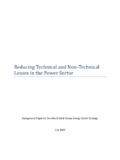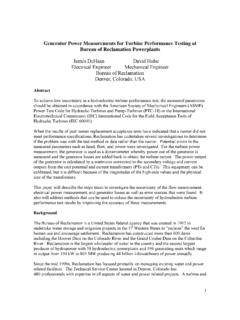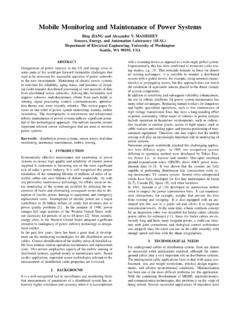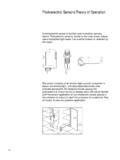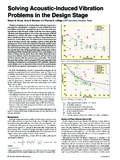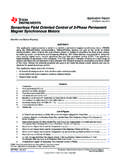Transcription of Disaster Mitigation is Cost Effective - World Bank
1 background Note Disaster Mitigation is cost Effective Ilan Kelman CICERO, Norway Disaster Mitigation is cost Effective Ilan Kelman, Senior Research Fellow, CICERO, Norway Summary This document is a briefing on cost -benefit analyses (CBA) for Disaster risk reduction (DRR) based on studies documented at 1. The evidence The most cost - Effective forms of DRR investment tend to be non-structural approaches such as land use planning, warning systems, and household-level changes but these are often backed by structural measures, making full separation difficult.
2 For instance, for earthquakes, bolting down appliances and securing shelves costs several hundred dollars in order to save several thousand dollars in damage averted. That presumes that the entire building will stand up in an earthquake because it has been engineered with seismic safety measures. Similarly for floods, the more structural a measure, the less cost - Effective it usually is but structural and non-structural measures are not always separable. For flood damage in Apia, Samoa, Woodruff (2008) calculated benefit- cost ratios of to 44 for improved forecasting and raising floors in homes compared to to for floodwalls.
3 In the Philippines, Burton and Venton (2009) reported results for village floods which were preventing children from going to school, damaging property, and preventing crops from reaching market. For building and maintaining structures, the benefit- cost ratio was 24 for a footbridge, for a sea wall, and for a dyke. For weather and water information and early warning systems across Europe, Hallegatte (2012) calculates that benefit- cost ratios would be between 4 and 36, in addition to the lives saved but only because much of the expensive and large-scale infrastructure needed, namely satellite networks and forecasting models such as those run by supercomputers, exists already.
4 That is, given what is already available, the value added of small investments in non-structural DRR approaches is immense. Starting from scratch, the benefit- cost ratios would be much lower. Consequently, the general trend stated above is not definitive. Similarly, counterexamples exist. For flood management along Pakistan s Lai River, Kull et al. (2013) reported benefit- cost ratios of for floodplain relocation, for a warning system, for river improvement, for a retention pond, and for combining the latter two. For floods in Kinshasa, DRC, Setchell (2008) calculated that mainly structural DRR measures, but completed with local labor and materials, saved at least $ for every $1 invested and this ratio was witnessed each year that floods occurred.
5 Across numerous countries, Kunreuther and Michel-Kerjan (2012) examined mainly structural measures for earthquakes, floods, and hurricanes/cyclones along with early warning systems for developing countries. The results were mixed. For example, by targeting some, but not all, flood-vulnerable communities for building flood walls, a benefit- cost ratio of 60 was achieved along with saving 20,000 lives. Meanwhile early warning systems yielded benefit- cost ratios of 1 to , so it is not definite that significant savings result. The scattering of results amongst various measures and locations highlights the lesson that context matters.
6 As Godschalk et al. (2009) summarize with respect to DRR grants in the : each dollar spent on Mitigation grants saves society an average of $4 in real resource costs. As expected, benefit- cost ratios varied across hazards, reflecting individual hazard characteristics and local Mitigation priorities. That is, results are usually neither generalizable nor transferable elsewhere. For a volcano, Newhall et al. (1997) analyze the 1991 eruption of Mount Pinatubo in the Philippines. They give the monitoring and response costs at $ million while the amount of property damage averted as a result of these actions is estimated to be a minimum of $500 million, not including over 5,000 lives saved.
7 The equipment and lives saved, though, included those evacuated from two military bases which were severely damaged by the eruption. Not every location has such affluent assets at risk. As well, the nature of the vulnerability sometimes dictates the nature of the DRR intervention. IADB et al. (2005) list examples of infrastructure destruction by tropical cyclones across four Caribbean islands, concluding In all cases, the cost of rebuilding after the Disaster was more than double the Mitigation cost , and in the case of the Manley Library, reconstruction costs came to 20 times the Mitigation cost .
8 In each instance, engineering measures were the only Mitigation measures possible to keep the buildings and bridges standing during winds and floods. 2. Quality of the evidence A high quality and credibility of evidence is seen for two study categories: (i) studies published in peer-reviewed academic journals ( Godschalk et al., 2009) and (ii) studies which provide the detailed calculation methods and numbers ( Setchell, 2008). These types of studies are used for the above discussion. Other studies and reports simply quote a ratio without providing sources, citations, or details.
9 These studies are not used in the above analysis because the quality of that work is inadequate, leading to major misunderstandings. As a prominent example, many politicians and reports quote the World Bank as having calculated that DRR saves $7 (sometimes $4-7) for every $1 invested. One variation is that the World Bank and Geological Survey showed that $40 billion invested in DRR would have reduced Disaster losses during the 1990s by $280 billion. No original, verifiable citations, calculations, or methods have yet been found, so the World Bank no longer promotes these numbers.
10 The high quality of studies with peer-review or full calculations must be tempered with limitations on the CBA method itself. Many subjective decisions must be made to reach the final ratio. Examples are the discount rate, the value of life and health, the opportunity cost of resources used for DRR, and which intangible costs and benefits to include. CBA as a method demands numbers. Some of the arguably most important benefits ( feeling of security and preserving life) and arguably most significant costs ( the emotional burden of selling and moving from one s home to be out of a high risk zone) are not readily quantifiable.










